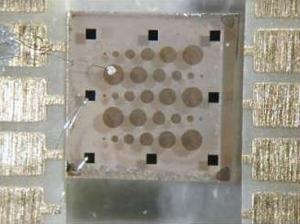 In the 1980s and '90s, competition in the computer industry was all about "clock speed" -- how many megahertz, and ultimately gigahertz, a chip could boast. But clock speeds stalled out almost 10 years ago: Chips that run faster also run hotter, and with existing technology, there seems to be no way to increase clock speed without causing chips to overheat.
In the 1980s and '90s, competition in the computer industry was all about "clock speed" -- how many megahertz, and ultimately gigahertz, a chip could boast. But clock speeds stalled out almost 10 years ago: Chips that run faster also run hotter, and with existing technology, there seems to be no way to increase clock speed without causing chips to overheat.
In this week's issue of the journal Science, MIT researchers and their colleagues at the University of Augsburg in Germany report the discovery of a new physical phenomenon that could yield transistors with greatly enhanced capacitance -- a measure of the voltage required to move a charge. And that, in turn, could lead to the revival of clock speed as the measure of a computer's power.
In today's computer chips, transistors are made from semiconductors, such as silicon. Each transistor includes an electrode called the gate; applying a voltage to the gate causes electrons to accumulate underneath it. The electrons constitute a channel through which an electrical current can pass, turning the semiconductor into a conductor.
Capacitance measures how much charge accumulates below the gate for a given voltage. The power that a chip consumes, and the heat it gives off, are roughly proportional to the square of the gate's operating voltage. So lowering the voltage could drastically reduce the heat, creating new room to crank up the clock.
MIT Professor of Physics Raymond Ashoori and Lu Li, a postdoc and Pappalardo Fellow in his lab -- together with Christoph Richter, Stefan Paetel, Thilo Kopp and Jochen Mannhart of the University of Augsburg -- investigated the unusual physical system that results when lanthanum aluminate is grown on top of strontium titanate. Lanthanum aluminate consists of alternating layers of lanthanum oxide and aluminum oxide. The lanthanum-based layers have a slight positive charge; the aluminum-based layers, a slight negative charge. The result is a series of electric fields that all add up in the same direction, creating an electric potential between the top and bottom of the material.
Ordinarily, both lanthanum aluminate and strontium titanate are excellent insulators, meaning that they don't conduct electrical current. But physicists had speculated that if the lanthanum aluminate gets thick enough, its electrical potential would increase to the point that some electrons would have to move from the top of the material to the bottom, to prevent what's called a "polarization catastrophe." The result is a conductive channel at the juncture with the strontium titanate -- much like the one that forms when a transistor is switched on. So Ashoori and his collaborators decided to measure the capacitance between that channel and a gate electrode on top of the lanthanum aluminate.
They were amazed by what they found: Although their results were somewhat limited by their experimental apparatus, it may be that an infinitesimal change in voltage will cause a large amount of charge to enter the channel between the two materials. "The channel may suck in charge -- shoomp! Like a vacuum," Ashoori says. "And it operates at room temperature, which is the thing that really stunned us."
Indeed, the material's capacitance is so high that the researchers don't believe it can be explained by existing physics. "We've seen the same kind of thing in semiconductors," Ashoori says, "but that was a very pure sample, and the effect was very small. This is a super-dirty sample and a super-big effect." It's still not clear, Ashoori says, just why the effect is so big: "It could be a new quantum-mechanical effect or some unknown physics of the material."
There is one drawback to the system that the researchers investigated: While a lot of charge will move into the channel between materials with a slight change in voltage, it moves slowly -- much too slowly for the type of high-frequency switching that takes place in computer chips. That could be because the samples of the material are, as Ashoori says, "super dirty"; purer samples might exhibit less electrical resistance. But it's also possible that, if researchers can understand the physical phenomena underlying the material's remarkable capacitance, they may be able to reproduce them in more practical materials.
Triscone cautions that wholesale changes to the way computer chips are manufactured will inevitably face resistance. "So much money has been injected into the semiconductor industry for decades that to do something new, you need a really disruptive technology," he says.
"It's not going to revolutionize electronics tomorrow," Ashoori agrees. "But this mechanism exists, and once we know it exists, if we can understand what it is, we can try to engineer it."

 Previous page
Previous page Back to top
Back to top







